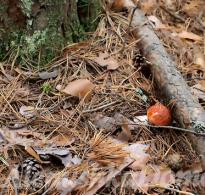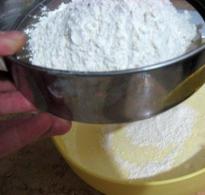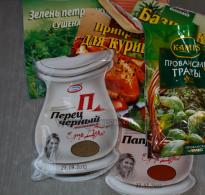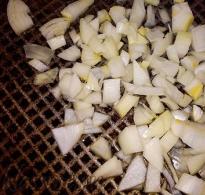Pale grebe poisoning dose. Toadstool poisoning
What is Toadstool Poisoning?
Most severe poisoning observed by the pale grebe (Amanita phalloides). The toxins of the toadstool (phalloidins and amanitins) are indole derivatives.
What Causes Toadstool Poisoning
Amanitotoxins are heat-stable and do not decompose even with prolonged heating at a temperature of 100°C. One mushroom is enough to cause fatal poisoning. Phalloidotoxins are not absorbed in the digestive tract, so they are non-toxic; amanitins are resorbed relatively quickly, their circulation time in the blood does not exceed two days, part of the toxin binds to proteins that act as a nonspecific protective barrier.
Human enzyme systems do not destroy amanitotoxins and do not reduce their toxicity. Absorbed toxins are deposited in the tissue by 60%. Amanitins are excreted through the kidneys; they are detected in the urine after 17-20 hours. The pallid grebe has an entero-, hepato- and nephrotoxic effect on humans. Amanitotoxins act on the nuclear substances of hepatocytes and cause cell autolysis. They inhibit liver enzymes that regulate the metabolism of proteins, fats and carbohydrates. Toadstool poisoning results in necrosis and fatty degeneration of the liver.
Symptoms of Toadstool Poisoning
Clinical picture:
Latent period gastroenteric syndrome, hepato- and nephropathy are distinguished.
The onset of the clinic is preceded by a latent period (from 8 to 21 hours). the phase of acute gastroenteritis begins suddenly with vomiting or uncontrollable vomiting, after a few hours enteritis occurs. The stool is profuse, foul-smelling, often mixed with blood, its frequency reaches 20-25 times a day. There is usually no increase in temperature. The picture of hyposalemia and dehydration of the body, blood thickening increases, oliguria occurs, and the level of urea increases.
Already on the 1st-2nd day from the moment of poisoning, the activity of transaminases increases, initially aspartic and then alanine. After the end of hepatocyte cytolysis (5-6 days), the AST level quickly normalizes. The increase in ALT lasts much longer.
Around the 5-7th day from the moment of poisoning, jaundice appears, which has varying degrees of severity. Hepatopathy contributes to severe disseminated intravascular coagulation syndrome, the level of prothrombin decreases to 30% and below. Clinically, this is manifested by hemorrhages on the skin, nosebleeds, hemoptysis, hematemesis and tarry stools. In the terminal phase, the patient may develop acute liver failure (hepatic coma). Fatalities are more than 50%.
Treatment of Toadstool Poisoning
Rinse the stomach, give activated charcoal and a saline laxative. In case of indomitable vomiting, gastric lavage is not advisable. On days 1-2, hemosorption and plasmapheresis are indicated. To combat dehydration, it is necessary to carry out infusion therapy (3-5 l/day) under the control of central venous pressure and electrolyte levels. Some antibiotics (kanamycin, eomycin), especially those introduced into the gastrointestinal tract, have an antidote effect.
To protect the liver, unithiol, lipoic acid, vitamin E, and essentiale are recommended. The administration of protease inhibitors (contrical, trasylol, gordox) is indicated. To reduce intoxication, 250-500 ml of a 10% glucose solution with insulin is administered; for acidosis, 200 ml of a 4% sodium bicarbonate solution is administered. For hepatopathy, parenteral steroid hormones are indicated (300-500 mg of prednisolone per day).
In the first week, the diet is semi-liquid: 5-10% porridge in water, compotes, jelly, rosehip decoction, milk soups, vegetable broth. Meat, fish, fresh vegetables and fruits, not to mention other more difficult-to-digest foods. Bed rest is required for about 10 days.
With increasing liver failure, a liver transplant or the use of allogeneic liver hepatocytes is possible.
Which doctors should you contact if you have toadstool poisoning?
Toxicologist
Promotions and special offers
Medical news
14.08.2017
From August 15 to September 15, 2017, the Madis clinic network offers a special price for tests for schools and kindergartens.
18.04.2017
Scientists from the University of North Carolina have found that the immunodeficiency virus can be found not only in blood cells (T-cells), but also in other tissues of the body. Experts have determined that the virus may be inside so-called macrophages (amoeba-like cells).
13.04.2017
The Russian Ministry of Health has approved the drug Revolade (Eltrombopag) for use in children. The new drug is indicated for patients suffering from chronic immune thrombocytopenia (idiopathic thrombocytopenic purpura, ITP), a rare disease of the blood system.
Almost 5% of all malignant tumors are sarcomas. They are highly aggressive, rapidly spread hematogenously, and are prone to relapse after treatment. Some sarcomas develop for years without showing any signs...
Viruses not only float in the air, but can also land on handrails, seats and other surfaces, while remaining active. Therefore, when traveling or in public places, it is advisable not only to exclude communication with other people, but also to avoid...
Regaining good vision and saying goodbye to glasses and contact lenses forever is the dream of many people. Now it can be made a reality quickly and safely. The completely non-contact Femto-LASIK technique opens up new possibilities for laser vision correction.
Cosmetics designed to care for our skin and hair may actually not be as safe as we think
Pale toadstool is often confused with mushrooms. Since the color of the mushroom cap becomes greenish with age, inexperienced mushroom pickers confuse the toadstool with some types of russula, greenfinch and floaters.
This mushroom is deadly poisonous, and eating it leads to 90% death.
The pale grebe has external features structures that help distinguish this insidious mushroom from outwardly similar edible and conditionally edible mushrooms with which it is confused:
| Death cap | Champignon | Russula | Floats | greenfinch |
| Sem. Fly agaric | Sem. Champignon | Sem. Russula | Sem. Fly agaric | Sem. Ordinary |
| Edible | Edible | Conditionally edible | Conditionally edible. but is sometimes considered poisonous | |
| hat | ||||
| Diameter 5-15 cm, fibrous, becomes greenish or grayish in older specimens | Diameter from 3 to 25 cm, massive, dense, white with brownish scales | Size up to 14 cm, young mushrooms are whitish or greenish, old mushrooms are brown and thin | small, fragile. Some species are white or light gray in color | Size 4-15 cm, fleshy, dense, with small scales in the center |
| Records | ||||
| white, soft | In older specimens they turn brown to black | whites become creamy with age and disperse | thin, white, sometimes grayish or pinkish | greenish, lemon yellow |
| Pouch and ring included | ||||
| The volva (sac) is clearly defined, sometimes filmy remains of the veil are visible on the cap | Does not have a volva, but a dark, sometimes multi-layered ring is clearly visible | They don't have Volvos or rings | There is a volva, free, disappears with age. The ring is missing | They don't have Volvos or rings |
| Pulp | ||||
| does not change color when broken | whitish, turns yellow or red at the break | brittle, white turns yellow with age | thin, brittle, white | white, does not turn yellow with age, does not change color when broken |
| Stipe | ||||
| with a noticeable thickening at the base, white with a moire pattern | massive, hollow inside with a clearly visible ring from a dark blanket | massive, white. In older specimens with brown spots | thin, white, hollow, with scales or flakes, widened at the bottom, but without characteristic swelling | short, almost hidden in the ground, colored yellowish or greenish. with small scales and thickening at the base |
| Smell | ||||
| nice | Mushroom or anise | not felt | not felt | flour |
| Taste | ||||
| sweetish | Not expressed | sweetish | nice | unexpressed |
Young mushrooms are so similar to each other that it is very easy to confuse them. Moreover, the taste and smell of toadstool is pleasant and does not indicate its poisonous properties.
The characteristic thickening and volva are often covered with soil and fallen leaves. Mushroom pickers, cutting off only the cap, do not notice the characteristic differences, so poisoning with toadstool is common.
Composition and mechanism of action
The toadstool has an uneven distribution of toxins. The largest amount of them is found in the skin (cuticle) of the cap, but the stem and cap also contain a sufficient amount of poison for fatal intoxication.

The composition of toxic substances contained in the mushroom has been well studied. The studied toxins are divided into:
- amanitins or amanitotoxins – very poisonous, the action is delayed;
- phalloidins or fallotoxins are somewhat less aggressive, but their effect is almost instantaneous.
This complex of toxic substances causes a delayed onset of symptoms of intoxication, but the destructive effect begins immediately after consumption poisonous mushrooms. The fungus has a pronounced plasmatoxic effect. Toxins long time(more than 2 days) do not cause noticeable signs of poisoning.
Penetrating into the systemic bloodstream, the complex enters the liver, lysing organ cells and destroying red blood cells. Fallotoxin, by binding to the cell membrane receptors of muscle fibers, blocks the transport of calcium ions, having a paralyzing effect on the muscles.
The complex of poisons causes:
- disruption of the synthesis of basic bioactive substances, blocking metabolic and energy processes;
- tissue necrosis of parenchymal organs and their fatty infiltration;
- damage to the integrity of the walls of blood vessels and hemorrhage;
- pathogenetic effect on the central nervous system.
Symptoms occur when toxins cross the blood-brain barrier and block the brain's ability to control internal organs.
Manifestations of intoxication
When poisoned by toadstool, symptoms increase gradually. The effect of the toxin on the muscles of the intestines and stomach causes increased synthesis of organ secretions - mucus and gastric juice. As a result, the patient develops severe diarrhea, and the destructive effect of the poison on the blood vessels contributes to the appearance of blood in the stool.
As a result of repeated vomiting and indomitable diarrhea, the patient’s body loses fluid, the blood becomes thicker, and the risk of blood clots increases, which is facilitated by the destruction of red blood cells and damage to the vascular endothelium. Because of the fall blood pressure and oxygen starvation, the patient has pallor of the skin, cyanosis of the lips, nasolabial triangle and nail bed.
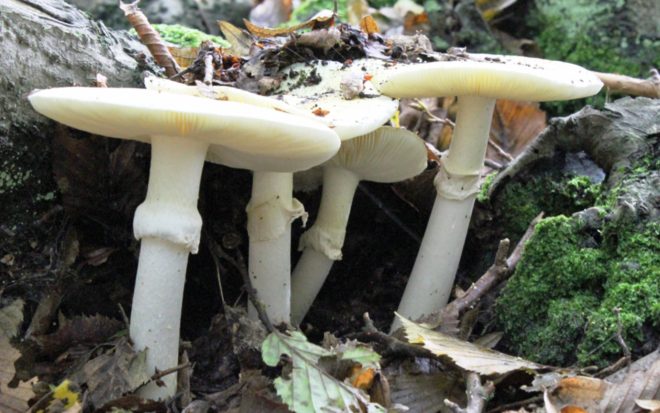
The extremities become cold, muscle cramps are noted. The patient experiences severe thirst, the skin becomes dry, and diuresis is greatly reduced. Pinpoint hemorrhages are observed on the skin, and nasal and pulmonary bleeding may occur. Due to a violation of the outflow of bile, yellowing of the sclera and skin occurs.
The neurotoxic effect manifests itself:
- dizziness;
- loss of consciousness;
- decreased visual acuity;
- cerebral edema.
The general picture of the lesion corresponds to the symptoms of poisoning by destructive toxins. Particularly noted is fatty infiltration of internal organs - liver, kidneys, spleen, heart, pancreas and salivary glands. The deposition of adipose tissue is also detected in the muscles. Hemorrhages also occur in all organs and in the brain. Diffuse degenerative damage to nerve fibers occurs.
After some time (after 2-3 days), an imaginary improvement in the condition is noted, which can be mistakenly taken for recovery. This stage lasts from 2 to 4 days and ends with a sharp deterioration in the patient’s condition. The irreversible changes that have occurred by this time in the tissues of the liver, kidneys, spleen and heart lead to the second stage of deterioration and death of the patient in 8-30% of cases.
The patient has a hepatic coma, from which, as a rule, it is not possible to bring the patient out. A feature of post-mortem examination in case of poisoning with toadstool is the absence of rigor mortis and a large number of subcutaneous hematomas. Currently, there is only one antidote to the venom of the toadstool - silibinin or Legalon SIL.
Scientists continue to work on obtaining a drug that can neutralize toxins and protect liver cells from their damaging effects. Homeopaths try to treat poisoning with homeopathic dilutions of toadstool toxins, which leads to neutralization of the poison.
Giving medications without a doctor's prescription is prohibited. Intensive therapy is carried out in a hospital setting. When collecting mushrooms, remember that the toxins of the toadstool are not destroyed by heat treatment, freezing or drying.
This mushroom does not lose its toxic properties when boiled, pickled or fried. The mortality rate from poisoning with its toxins is comparable only to the mortality rate from botulism.

Poisoning with toadstool toxins occurs mainly individually or in families. Massive cases of poisoning have not been observed for more than 100 years. The latest reported case was a mass poisoning in an orphanage in Bordeaux (France) that resulted in the death of 11 children.
Poisoning with this type of mushroom is predominantly observed during personal harvesting, partly with purchased mushrooms, and there are no registered cases of poisoning with industrially processed mushrooms.
Even 2-3 specimens included in the total mass of edible mushrooms cause severe intoxication. The spores of the fungus are also poisonous. They can infect those growing nearby edible species and, if not properly cleaned, cause mild poisoning.
Food poisoning is always difficult for the body to tolerate, but one of the most severe types is mushroom intoxication. A separate point worth mentioning is poisoning with toadstool, in such a situation most cases are fatal.
Among the poisonous mushrooms death cap- first
Among the poisonous mushrooms, toadstool is the first; it is one of the most toxic mushrooms for human body. That is why you need to know the signs of poisoning, what first aid should be for poisoning with toadstool, and what treatment will be prescribed to the victim. But first things first.
How does mushroom poison affect our body?
Toadstool contains two groups of harmful substances that have a negative effect on the human body. The first is phalloidins. They are less toxic than the next group, differ in the speed of action and protection from heat treatment.
The second group is alpha-aminitins. These substances are more toxic, but act on the body much more slowly than the previous ones. The intestines are not able to digest either the first or the second group of these poisons, so the main defense is the liver, which bears the blow of these toxins.
Poisons in the body cause gastritis, the structure of the liver is destroyed, and its cells begin to fill with fat; Blood circulation in the intestines and general metabolism in the body are disrupted, and glucose levels decrease. As you can see, poisoning with toadstool carries great harm for humans, so you need to know the symptoms of intoxication.
Symptoms of poisoning with toadstool

Symptoms of the second stage: vomiting, thirst, pain in the abdomen and intestines
There are several stages in the development of poisoning, and as stages change, so do the symptoms. Cases are different, so the body’s reaction differs and the consequences of mushroom poisoning may differ. Also, the signs of intoxication themselves depend on the concentration of the poison and the body’s individual resistance to it. Symptoms of each stage.
- The first period if you are poisoned by mushrooms is the latent period. Its average duration is about twelve hours (the first feature of toadstool intoxication is that it is impossible to detect self-poisoning and take the necessary treatment). Since the signs appear later, this greatly complicates the situation and worsens the general condition of the body - during this time the poisonous toxins have time to penetrate the blood and begin the operation to destroy cells.
- The second period lasts about two days. A characteristic symptom is loose stool (most often yellow or green color, can change its consistency, sometimes with blood). It is accompanied by vomiting, thirst, pain in the abdomen and intestines. The pressure may drop significantly, and this will be accompanied by headaches, blurred vision and coordination, pallor, and weakness. If the chlorine needed by the body is released along with the vomit, then there are cases when a person experiences cramps (most often in the calves). The blood begins to thicken, and urine production practically stops.
- The third period is the subsidence of symptoms. In case of mushroom poisoning, this period is the most dangerous. A person notices an improvement in the body’s condition (this happens within 24 hours), no treatment is required – it’s a common poisoning. But it is during this period of time that the poison begins to destroy liver cells; if the degree of poisoning is severe, then after twelve hours death can occur. Doctors call the third day a crisis.
- At the fourth stage of poisoning with toadstool mushrooms, the effect on internal organs. The mucous membranes of the mouth and eyes turn yellow, also symptoms of the fourth period are the restoration of loose stools, nephropathy. If the degree of mushroom poisoning is severe, then the signs are liver, kidney and heart failure, and it is because of the latter that deaths occur. Treatment at this stage is unsuccessful in half of the cases.
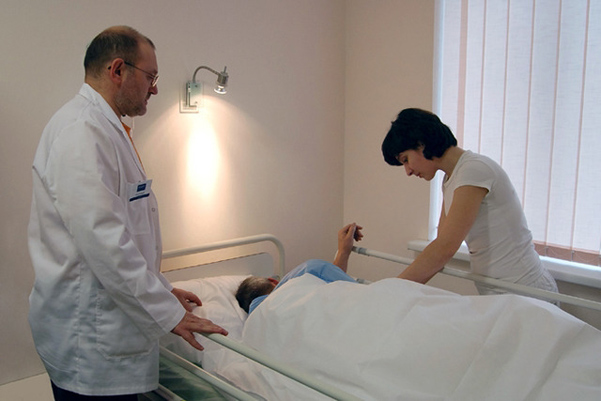
Doctors call the third day a crisis
Death from mushroom poisoning occurs in about ten days, the condition of your cardiovascular system is of great importance.
If the disease is favorable (for example, in the case of mild intoxication), then treatment proceeds without difficulty, and the patient quickly recovers. In the case of severe poisoning, rehabilitation takes quite a long time - at least a month, or even a couple. The symptoms go away gradually, and the jaundice goes away after two weeks, but all organs are completely restored, and work returns to normal.
First aid for poisoning
By the time the symptoms of poisoning appear, the poison has already entered the bloodstream, so the first aid provided will be ineffective. As soon as you notice signs of mushroom poisoning, you should immediately call ambulance(this is very an important condition, the sooner you contact, the greater the chances of recovery). Treatment will not be difficult if you go to the hospital no later than thirty-six hours after eating the mushroom.
Before the doctor arrives, you need to perform a number of actions that will help remove toxins from the body:
- if there is no vomiting, then it is necessary to induce them to clear the stomach. You need to give the victim a liter to drink warm water, then press on the root of the tongue
- give the poisoned person a pill to take activated carbon, which is an excellent adsorbent (calculation - one tablet per 10 kilograms of weight).

Before the doctors arrive, try to rinse your stomach
Treatment for mushroom poisoning
Treatment for mushroom poisoning - difficult process, since the poison is already in the blood, and a special antidote for removing toxins from the circulatory system has not yet been invented. Therefore, as is the case with food poisoning, treatment is carried out symptomatically.
- Gastric lavage is performed.
- Since an antidote has not been developed, benzyl penicillin is injected into the body (if three days have not passed since the poisoning). There should be six such techniques. Then Silibinin is used (the course of this drug is designed for two weeks), sometimes they can be treated with lipoic acid.
- An excellent remedy for combating dehydration is Acesol, which is injected into the patient’s vein (sometimes saline solution, Trisol, and so on are added to it). A drip is placed, which restores the level of glucose in the liver. After severe vomiting and loss of chlorine from the body, it can be used intravenously or by drinking salt water.
- In order for toxins to be eliminated from the body faster, homosorption is done.
- Further treatment is the prescription of cardiac medications that have a positive effect on the cardiovascular system.
- For a high level of blood clotting, enzymes such as Gordox, Contrical are included in the treatment.
- Prescribing B vitamins to support healthy liver function. Of course, the result of treatment depends solely on how much poison enters the body.

Treatment for mushroom poisoning is a complex process
Prevention of poisoning
To prevent poisoning from occurring, you need to remember a few simple rules:
- do not pick mushrooms that are unfamiliar to you;
- do not buy mushrooms from people you don’t know;
- carefully check the mushrooms you are going to eat.
You already know the symptoms of poisoning with toadstool; the features of intoxication with toadstool have also already been mentioned. It is important to consult a doctor at the first onset of symptoms, then the chances of a favorable outcome double.
Also remember that severe poisoning can be fatal, so you should Special attention pay attention to checking mushrooms (it is recommended to check champignons, since toadstool is often mixed with them). Be careful, and then everything will be fine with your health!

